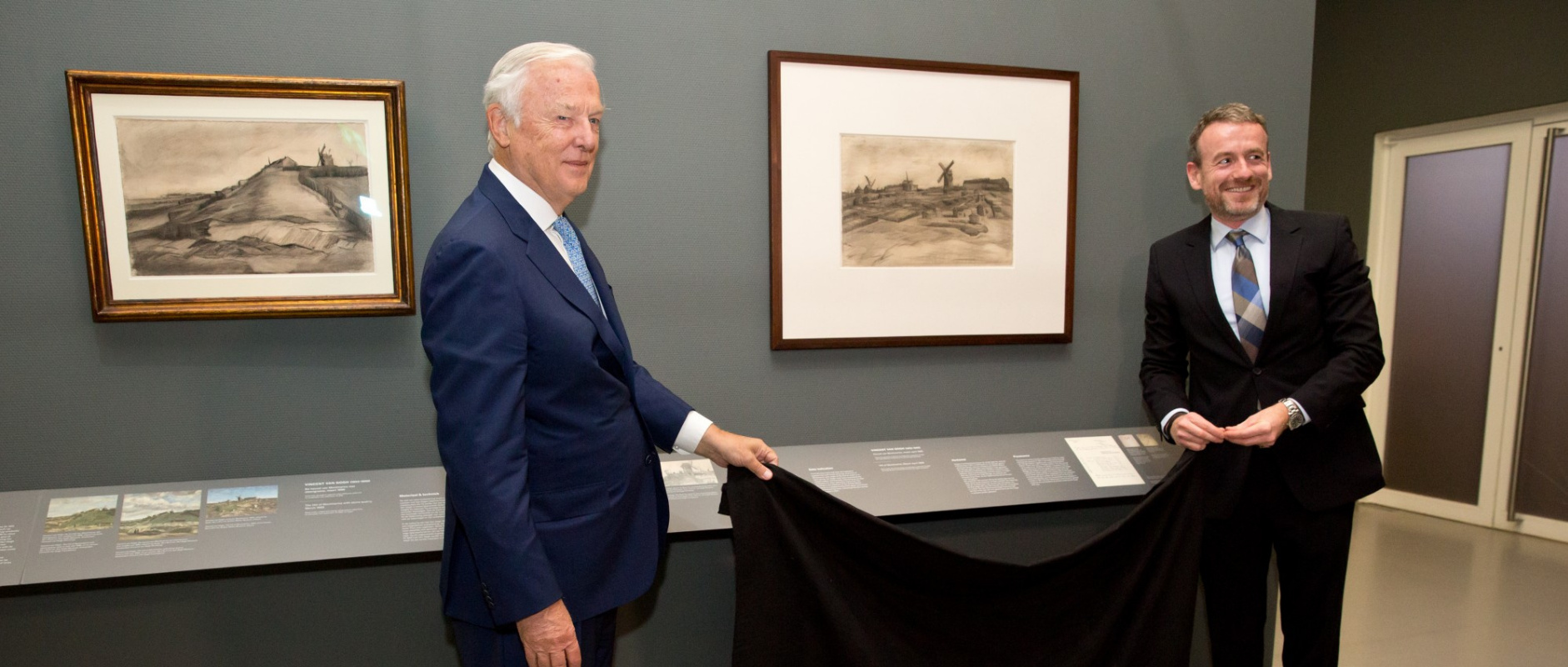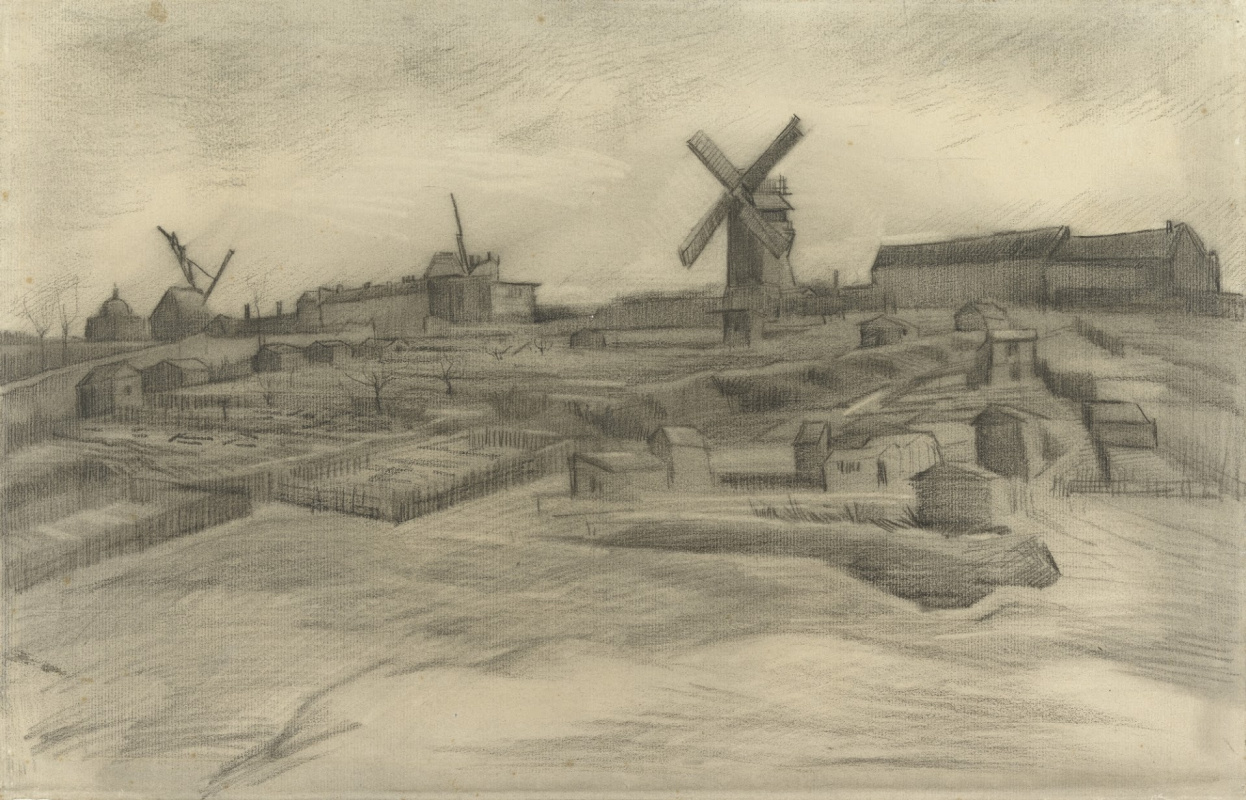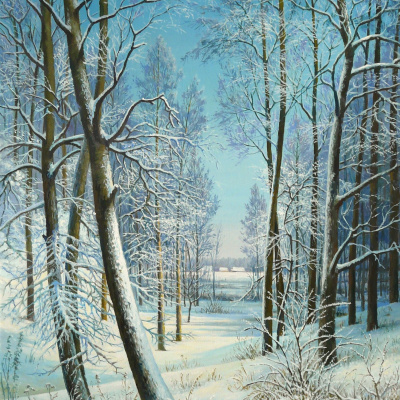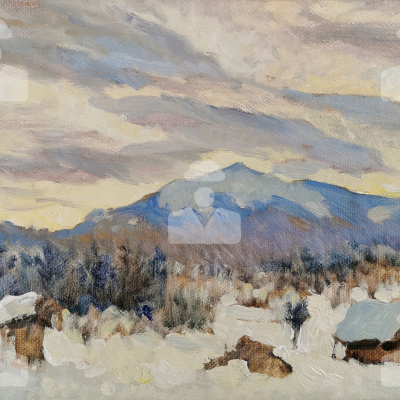A new drawing was discovered in the Van Vlissingen Art Foundation’s collection. The Hill of Montmartre with Stone Quarry dating March 1886 was attributed to Vincent van Gogh by the Van Gogh Museum experts following their extensive research. With this attribution, a comparable drawing that was previously discrown, now credited to Van Gogh as well. Both of the sketches can be seen until 6 May in the exhibition "Impressionism & Beyond. A Wonderful Journey" at the Singer Laren Museum in Netherlands.

The painter Vincent van Gogh has always been very inspiring. This year, has passed only a little more than two weeks, and the buzz surrounding his genius has already increased its momentum. The upsurge in interest was caused by the groundbreaking attribution of a drawing discovered in the Van Vlissingen Art Foundation’s collection, The Hill of Montmartre with Stone Quarry dating March 1886, to the Dutch artist.
The Hill of Montmartre with Stone Quarry
1886, 31×48 cm
The extensive research by the Van Gogh Museum on the subject, style, technique, use of materials and origin of this previously unknown drawing led experts to the conclusion that this monochrome drawing was made by Vincent in 1886, when he left Antwerp for Paris to study at Fernand Cormon’s studio and improve his knowledge and skill in figure drawing and painting.
Vincent van Gogh joined Cormon’s "atelier libre" (open studio) in early March 1886, just after his arrival in Paris and spent a few months there. We can read about it from his letter to Horace Mann Livens, his fellow-artist: "I have been in Cormons studio for three or four months but did not find that as useful as I had expected it to be."
Vincent van Gogh joined Cormon’s "atelier libre" (open studio) in early March 1886, just after his arrival in Paris and spent a few months there. We can read about it from his letter to Horace Mann Livens, his fellow-artist: "I have been in Cormons studio for three or four months but did not find that as useful as I had expected it to be."
Vincent van Gogh had settled in Montmartre on 28 February 1886, the district of Paris where different artists lived and worked. He moved into his brother Theo’s small apartment at 25 Rue Laval and later relocated into more comfortable flat at 54 Rue Lepic, where Theo and his wife set a small room for Vincent so that he could use it as a studio. The fourth-floor flat in Montmartre looked out over the city. Vincent painted the view several times, he preferred being outside on the streets of Montmartre, where subjects presented themselves to him — outdoor life, the windmills on the hill, the cafés.
The Van Gogh Museum experts found that the newly found drawing has been kept by Theo and his wife from the beginning. This actually helped the researchers to attribute the drawing. A meticulous keeper of van Gogh’s materials, van Gogh’s sister-in-law, Johanna van Gogh-Bonger numbered a sketch "123" in her inventory. And the Van Gogh museum’s senior researcher Teio Meedendorp said that when he took the drawing out of its frame , he found the telltale number, "123," written on the back.
The chalk drawing was a part of the pair’s collection, until Theo’s widow Johanna van Gogh-Bonger consigned it to the art dealer J.H. des Bois in 1911. He then sold the work around 1917, and the work disappeared from view of art-historians. This happened 11 years prior the first catalogue of Van Gogh’s oeuvre was published (De la Faille, 1928). That’s why the drawing has never before been exhibited or included in a publication.
The disappeared Van Gogh drawing was actually discovered in 2013 when it was brought by an American private collector to the Van Gogh Museum for research, according to Mr. Meedendorp. As it goes, Dutch relatives of the collector had bought the piece from a gallery in the Netherlands in 1917. The museum, however, did not announce the discovery initially, at the request of the former owner.
"After it came in we verified that it was indeed a Van Gogh," said Mr. Meedendorp, "but we were intrigued by the question of its origins."
The Van Gogh Museum experts found that the newly found drawing has been kept by Theo and his wife from the beginning. This actually helped the researchers to attribute the drawing. A meticulous keeper of van Gogh’s materials, van Gogh’s sister-in-law, Johanna van Gogh-Bonger numbered a sketch "123" in her inventory. And the Van Gogh museum’s senior researcher Teio Meedendorp said that when he took the drawing out of its frame , he found the telltale number, "123," written on the back.
The chalk drawing was a part of the pair’s collection, until Theo’s widow Johanna van Gogh-Bonger consigned it to the art dealer J.H. des Bois in 1911. He then sold the work around 1917, and the work disappeared from view of art-historians. This happened 11 years prior the first catalogue of Van Gogh’s oeuvre was published (De la Faille, 1928). That’s why the drawing has never before been exhibited or included in a publication.
The disappeared Van Gogh drawing was actually discovered in 2013 when it was brought by an American private collector to the Van Gogh Museum for research, according to Mr. Meedendorp. As it goes, Dutch relatives of the collector had bought the piece from a gallery in the Netherlands in 1917. The museum, however, did not announce the discovery initially, at the request of the former owner.
"After it came in we verified that it was indeed a Van Gogh," said Mr. Meedendorp, "but we were intrigued by the question of its origins."
The Hill of Montmartre
1886, 31.8×47.8 cm
What adds to the importance of the discovery of this sketch
is that the Van Gogh Museum is now accepting a similar work in its own collection that it had rejected a few years ago.
Entitled likewise The Hill of Montmartre, this second drawing, had been in two catalogues raisonnés in the 1970s, but for some reason it was rejected in 2001 by the museum’s experts. The specialists then mentioned the drawing’s "cautious, dutiful draughtsmanship", the "lack of monumentality in the buildings" and a sky that is rendered very differently from Van Gogh’s style. Why? Museum said because they "lacked the material for comparison." With the find of the first sketch , that opinion has now been reversed, and the museum accepts its own drawing as authentic.
According to Teio Meedendorp, "The two drawings are clearly from the same hand and stylistically, are reminiscent of Van Gogh’s model drawings from early 1886, which he initially created in Antwerp and subsequently in Paris, in Cormon’s studio."
Entitled likewise The Hill of Montmartre, this second drawing, had been in two catalogues raisonnés in the 1970s, but for some reason it was rejected in 2001 by the museum’s experts. The specialists then mentioned the drawing’s "cautious, dutiful draughtsmanship", the "lack of monumentality in the buildings" and a sky that is rendered very differently from Van Gogh’s style. Why? Museum said because they "lacked the material for comparison." With the find of the first sketch , that opinion has now been reversed, and the museum accepts its own drawing as authentic.
According to Teio Meedendorp, "The two drawings are clearly from the same hand and stylistically, are reminiscent of Van Gogh’s model drawings from early 1886, which he initially created in Antwerp and subsequently in Paris, in Cormon’s studio."

From left to right: Fred Leeman, an independent Van Gogh expert and curator of the exhibitions; consultant to the Van Vlissingen Art Foundation; Jan Rudolph de Lorm, Director of the Singer Musemum in Laren; Axel Rüger, Director of the Van Gogh Museum; Treio Meedendorp, Senior Researcher at the Van Gogh Museum. Photo: courtesy of the Van Vlissingen Art Foundation.
Teio Meedendorp explained that these two rare sketches are more aligned with Vincent’s earlier formal style, which he developed at the art academy in Antwerp, before moving to Paris, where his work became more experimental. He said, "Within Van Gogh’s drawn oeuvre, these two striking works aptly illustrate how the artist was still very much seeking his own style in the winter/spring 1886 period. They demonstrate a phase in Van Gogh’s learning process — in Paris, he rediscovered himself, but here, he was still following the traditional artistic path."
"It is fantastic news that two drawings can now be definitively be added to Van Gogh’s oeuvre," Van Gogh Museum director Axel Rüger said in a statement.
"It is fantastic news that two drawings can now be definitively be added to Van Gogh’s oeuvre," Van Gogh Museum director Axel Rüger said in a statement.

Left: Jan Rudolph de Lorm, Director of the Singer Musemum in Laren; right: Axel Rüger, Director of the Van Gogh Museum. Photo: courtesy of the Van Vlissingen Art Foundation.
Both drawings can be seen until 6 May 2018 in the exhibition "Impressionism & Beyond. A Wonderful Journey" at the Singer Laren Museum, Netherlands. It also features art works by French impressionists, post-impressionists and expressionists from the Van Vlissingen Art Foundation, including works by artists such as Monet, Manet, Renoir, Signac, Matisse and Picasso.
Written on materials of Van Vlissingen Art Foundation, Singer Laren, Van Gogh Museum, Amsterdam, World Art Foundations, Van Gogh Route, APF, The New York Times, Art Net News, the Art Newspaper, Hyperallergic, Same Day Newspaper.
Title illustration: John Fentener van Vlissingen, art collector of the Van Vlissingen Art Foundation and Axel Rüger, director of the Van Gogh Museum, unveiling the The Hill of Montmartre with Stone Quarry by Vincent van Gogh at the exhibition "Impressionism & Beyond. A Wonderful Journey" at the Singer Laren Museum, Netherlands on Tuesday, 16 January 2018. Photo: Singer Laren.
Title illustration: John Fentener van Vlissingen, art collector of the Van Vlissingen Art Foundation and Axel Rüger, director of the Van Gogh Museum, unveiling the The Hill of Montmartre with Stone Quarry by Vincent van Gogh at the exhibition "Impressionism & Beyond. A Wonderful Journey" at the Singer Laren Museum, Netherlands on Tuesday, 16 January 2018. Photo: Singer Laren.





























